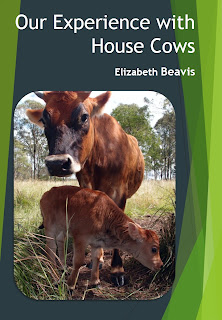"Have you ever thought about owning a house cow but don’t know where to start? Do you dream of unlimited raw milk, manure and beef to complement your small farm activities? “Our experience with House Cows” is an eBook written by a house cow owner to help other small farmers get started with a cow of their own. The eBook is written for Australian conditions, particularly sub-tropical Queensland, but much of the information is applicable to cows and cow owners all over the world. This eBook covers the basics of getting a cow, getting her in calf, milking her and caring for her calf, all using natural methods. The final sections explain how to use all that milk to create delicious dairy products! The eBook references several other cow, cattle and dairy books which are useful to the new cow owner and explain some aspects in more detail. Go ahead, learn how to realise your house cow dream today!"
Liz had contacted me a year ago about helping her write the chapter on hand milking a house cow, as Liz uses a milking machine. So I'm very excited that her ebook is finished and available to those thinking of keeping a house cow. It is a wealth of information and although written from an Australian prospective, a cow is the same every where and the same cow rules apply!
Liz writes a smallholding/homesteading blog called 'Eight Acres' and you can download her ebook from her house cow blog . It costs $4.99 Australian dollars and is downloaded in PDF format.
The eBook features 41 pages of information and gorgeous house cow photos.
Table of Contents:
1. Introduction. 1
1.1. About us. 1
1.2. About this book. 1
1.3. Conversion of units. 2
1.4. House cow terminology. 2
2. Why own a house cow?. 4
2.1. Raw milk. 4
2.2. Manure. 4
2.3. Meat 5
2.4. Lawn mowing. 5
2.5. Companionship. 5
3. Bringing home a house cow.. 6
3.1. Preparing for your cow.. 6
3.2. Choosing a house cow.. 7
3.3. Where to find a house cow.. 9
3.4. Transport and ownership issues. 9
3.5. Getting to know each other. 9
3.6. Cow safety. 10
4. Milking. 11
4.1. The milking procedure. 11
4.2. Training your house cow.. 12
4.3. Using a milking machine. 12
4.4. Hand-milking. 16
4.5. Managing mastitis. 17
4.6. Using the calf as a share milker. 18
5. Calving. 19
5.1. Getting your cow “into calf”. 19
5.2. Pregnancy care and "drying off". 20
5.3. Birth of the calf 20
5.4. Colostrum.. 21
5.5. Cow mothering. 22
6. Calf care. 23
6.1. Bottle feeding a calf 23
6.2. Introducing a foster calf 23
6.3. Castration. 24
6.4. Weaning. 25
7. Pests, parasites, poisoning and preventing illness. 26
7.1. General approach. 26
7.2. Buffalo flies. 26
7.3. Ticks. 27
7.4. Intestinal Worms. 28
7.5. Vaccinations. 28
7.6. Poisoning. 28
8. The home dairy. 29
8.1. Using up the milk. 29
8.2. Making yoghurt 29
8.3. Making kefir. 30
8.4. Cream, butter and ice cream.. 31
8.5. Cheese without rennet 31
8.6. Cheese with rennet 31
9. A final word of advice. 33
10. References. 34
Appendix A: Milking bales design. 35
Appendix B: Useful sources of dairy equipment 37
Appendix C: Cheese press designs. 38
Appendix D: Sources of cheese making supplies and information.

Looks very informative, will have to have a look at that book thank you.
ReplyDeleteThanks for sharing this post I'm very intersted in this topic. Vets bundaberg At first you may even see typical signs equivalent to excessive fever and reddened eyes, however because the sickness continues the indicators will solely worsen. Anorexia, vomiting, diarrhea, seizures, and loss of life can happen. Analysis is completed with urine evaluation and biochemical checks by your trusted vet.
ReplyDelete